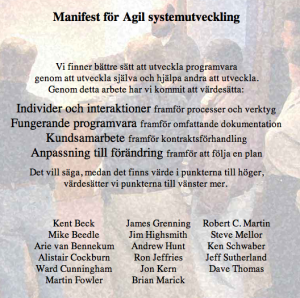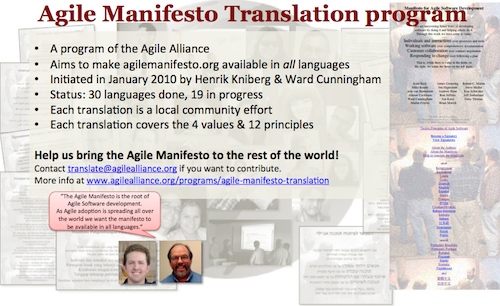In Feb 2001 17 thought leaders from the software community met at a ski resort in Utah to discuss and compare notes on how to succeed with software development. These people had independently been creating new methods such as Scrum, XP, and Dynamic Systems Development Method (DSDM). During the meeting, they discovered a strong common ground: a shared vision of how to succeed with software development. This became known as the Agile Manifesto. After the meeting they agreed on twelve principles behind these values.
Although the term Agile was coined in 2001, most Agile methods were created in the 1980s and 1990s. Agile is just an umbrella term, a description of the common denominator. Any method or approach that follows these values and principles can be considered Agile.
The Agile Manifesto is a historical document, a call for change. The wording of the manifesto resonated deeply with thousands of people around the world, causing somewhat of a revolution in software development. Ten years later, all the authors (except one) met again in the same location and concluded that they still stand behind agile values and principles. So, it seems that, despite the fast pace of change in the software industry, the Agile Manifesto is standing the test of time.
Although we have learned many things since 2001, the Agile Manifesto itself is not going to change, for the same reason as why we don’t update and maintain the Declaration of Independence, or the Magna Carta, or the meeting notes from last board meeting. It is a historical document, a snapshot of a moment of insight, not a living document.
Nobody owns the term Agile software development, so it has many interpretations. We know what Agile meant in 2001 (through the manifesto); today it is less clear. Many of the original manifesto authors hope that the term Agile will eventually fall out of use, signifying that the Agile values and principles have become simply “the way we do software.” I can only agree.
When the manifesto was created in 2001 the authors decided to call themselves the “Agile Alliance”, which has since evolved to a non-profit organization with the mission of “supporting those who explore and apply Agile principles and practices in order to make the software industry more productive, humane and sustainable”. The Agile Alliance is best known for the yearly Agile conference in the US (Agile 2010, Agile 2011, Agile 2012, etc), but they actually do many other things for the agile community as well.
I was on the Agile Alliance board of directors from 2009 to 2011 (and then stepped down because of a Big Family Trip), and one of our focus areas during that time was internationalization. As part of that effort I started the Agile Manifesto Translation program, which is now being run by Shane Hastie.
Most people in the world don’t speak English, and many people struggle with finding the right translation of the agile terms to their own language. The idea was that, if each community can discuss and agree on how to describe Agile in their own language, this should help spread agile adoption and lessen the risk for misunderstandings. So the mission of this program is to make the Agile Manifesto available in all languages of the world!
After discussion with Ward Cunningham and the other board members, we decided on this rough model:
- Each translation would be run by the local agile community in that country.
- Each language would have a lead translator, a volunteer who’s main job is to coordinate the translation effort and validate that the translation is supported by the local agile community.
- My job as program chair would be to set up the technology and processes to support this.
I then found an existing Swedish translation of the manifesto and set up an online form where Swedish agile community members could vote on the translation quality of each point of the manifesto, and offer improvement suggestions. I send that to the Agile Sweden mailing list, which generated a flurry of discussion and suggestions.
Through the hundreds of emails on the mailing list, and dozens of face-to-face conversation with people, we created three or four iterations of the Swedish manifesto and finally ended up with a stable version that most people liked and very few disliked.
The Swedish manifesto went live in February 2010, and the addition of the language menu was the first time that www.agilemanifesto.org had changed in 9 years!
- People care about this.
- The Agile Manifesto is a difficult document to translate. It is only two pages (the values and the principles), but the wording is very important and subtle.
- Involving the local agile community had a huge positive impact on the quality of the translation.
- The manifesto needs to be translated by the practitioners themselves. I tried at first involving a professional translation company, but that translation was no good at all. It was perhaps technically correct, but the essence of agile was lost. The practitioners did it much better. And free 🙂
- While discussing how to translate the manifesto, a more important thing was going on – the local agile community was getting together to discuss the meaning of agile – things like “who is the customer anyway?” and “what do we really mean by responding to change?” The translation effort was bringing us closer together, making the community less fragmented.
Inspired by this, we set up a simple process and basic tools for translation and issued a call for translators through my network – twitter, blogs, facebook, conferences, contacts such as the agile alliance board, etc.
The response was very strong! I was overwhelmed with offers to translate – within 2 days I had 17 people around the world offering to translate to 9 languages – and more kept coming every day. I spent a lot of time trying to ensure that the right person was leading each translation – a person who is truly bilingual, a person who is well connected and well respected within his local agile community, a person who is willing to do the work free and in collaboration with other people, and (if possible) a person who has previous experience doing translations.
Within 6 months we had 13 languages published, after another year we had 30 languages published.
For the Agile 2011 conference in Auguest 2011, I enlisted all the translators to help create an Agile Manifesto Translation Expo (here is the powerpoint original), which was laid out on the floor at the conference, and shown on the big screen during the 10 year reunion of the manifesto authors.
And the budget for this? 0$ 🙂
When I started the translation program I didn’t think it would be such a big deal, but the impact turned out to be greater than I had thought! I’m very grateful for all the positive feedback I’ve received from people. I was even invited to join a private meeting of the manifesto authors, after the Agile 2011 conference, and was surprised at how enthusiastic they were about this. Ward commented that “Honestly, I’m having a hard time imagining a more sincere tribute to the original work and the impact it has had than the effort you have lead. Thank you.”
I’d like to reflect that positive feedback back to everyone who has contribute to this program:
PS – if you wish to get involved feel free to get in touch with translate@agilealliance.org (current program director is Shane Hastie), or read more about the agile manifesto translation program.
Addendum: After reading this post Ward commented that the translation program has created new insights into the manifesto itself:
- Its brevity makes it somewhat ambiguous and this may be its strength and appeal.
- The teams assembled to interpret the text are the seeds to new communities.









One response on “How the Agile Manifesto went global – 34 languages and beyond”